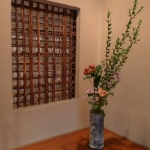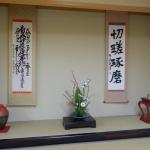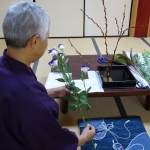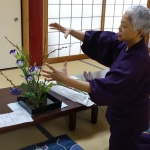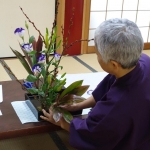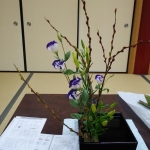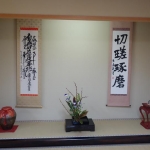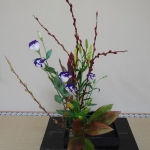Flower Arranging
Having seen them long,
I hold the flowers so dear
That when they scatter
I find it all the more sad
To bid them my last farewell.
–Saigyo
The temple bell stops but I still hear the sound coming out of the flowers
–Bashō
Kado, which literally means “The Way of Flowers,” is the Japanese art of arranging flowers.
The practice started in ancient times when flowers were arranged as offerings to a god or Buddha.
In the 15th or 16th century, a new style of architecture incorporating an alcove became popular, and it became tradition to place arranged flowers in the alcove to accentuate the room.
Kyoto is the home of Kado, and there are many flower arrangement schools with their heads actively supporting this traditional art.
Depending on the type of vase used (whether a shallow plate-shaped vase or jar-shaped vase), people use different styles of arranging flowers.
The Japanese flower arrangement creates a harmony of linear construction, rhythm, and color. While western flower arrangements tend to place more emphasis on the beauty of the blossoms themselves, Japanese flower arrangement emphasizes that flowers and plants should be used in their natural state as much as possible.
Flower arranging is not just for women. Traditionally, flower arranging was an essential part of the training of educated men, such as samurai and monks.
I had the pleasure of having a lesson with Sensei Masui Ryotoku who is the 33rd monk of a Nichiren temple in Kyoto. The temple itself has been in existence for over 580 years. She is a student of the Shogetsu school of flower arranging. She lives at the temple with her mother who was 87 years old at the time and a master calligrapher. I am very grateful for the time spent with them.
These are other opportunities to learn about flower arranging:
http://www.japan-talk.com/jt/new/17-Japanese-flower-meanings
http://www.ikebanahq.org/history.php
http://www.kpic.or.jp/english/japanese_culture/experience_classes.html
https://wakjapan.com/blog/prices/1605/
http://www.kafu.co/
http://teaceremony-kyoto.com/teaceremony-koto/ikebana-experience-by-an-ikebana-master-of-misho-school-in-japan/


